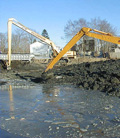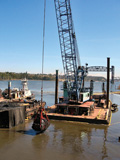Water: Contaminated Sediments
How to Manage






The appropriate sediment management option should be selected on a case-by-case basis, after careful consideration of the risks posed by the contaminants, the benefits of the remediation, and the costs. Contaminated sediments may either be left in place or removed. Contaminated sediments should not be removed from a site if doing so would cause more harm than simply leaving them in place. In some cases, experts determine that leaving sediments in place poses lower risks to the environment than removing them. If sediments are left in place, however, measures must be taken to limit the danger they pose to people and wildlife. Long-term biological and chemical monitoring should be established to measure any change in contaminant levels over time and the associated biological response.
Cap the sediment site
Contaminated sediments can be managed by waiting for new deposits of uncontaminated sand and silt to cover the contaminated area, capping it naturally. Another option is to the cap the contaminated site artificially by depositing a layer of clean clay, sand, gravel, or other material on top of it. If contaminated sediments are capped rather than treated or removed, the area around them must be monitored periodically to ensure that the toxic contaminants are not released.
Remove and dispose of sediment
Contaminated sediments also can be managed by removing the sediment. Cleaning up contaminated sediments can be expensive. If authorities decide to remove them, they must choose the kind of dredge most appropriate to site conditions. Sometimes, dredging uncovers unexpectedly high concentrations of contaminants beneath surface sediments.
After the sediments are dredged, they must be disposed of safely. Often they are placed in a Confined Disposal Facility (CDF), usually a diked area built in shallow water. Sometimes a CDF is built on dry land. Highly contaminated sediments may be placed in a special kind of CDF that works like a hazardous waste landfill.
Treat sediment
Different ways of treating sediment to remove or neutralize contaminants are being developed. They include isolating the contaminants from the rest of the sediments by separating the smallest grains (since contaminants tend to stick to them) and separating the oily part of the sediment (which contains most toxic organic compounds).
Sometimes sediments are incinerated to destroy organic contaminants. At other times, setting agents such as cement are added to solidify the sediments and prevent contaminants from being released into the environment. Bacteria and fungi may be added to break down, or biodegrade, certain contaminants; this process is called bioremediation. Advanced treatment approaches such as these are promising, but often expensive.
Because contaminants often come from numerous sources over a long period of time, determining who must pay for clean-up can be a problem. The cost of sediment remediation cannot be borne by government alone. Appropriate authority should be used to encourage voluntary clean-ups or compel responsible groups to clean up the sediments contaminated by their activities.
Efforts to manage contaminated sediments have already begun in some areas of the country, but many need further evaluation. Dealing with this problem is essential to prevent damage to wildlife, drinking water, public health, commerce, and recreation.
More Information
- EPA's Contaminated Sediment Management Strategy (1998)
- Realizing Remediation: A Summary of Contaminated Sediment Remediation Activities in the Great Lakes Basin (1998)
- Washington Department of Ecology Sediment Management Program

- Moving Mud: Remediating Great Lakes Contaminated Sediments (1997)
- Great Lakes Contaminated Sediments Program
- Publications: Methods for Measuring the Toxicity and Bioaccumulation of Sediment-associated Contaminants with Freshwater Invertebrates - Second Edition (2000)
- Minnesota Pollution Control Agency— Contaminated Sediments

- Wisconsin's Contaminated Sediment Program

- Beneficial Uses of Dredged Material
- National Conference on Management and Treatment of Contaminated Sediments (1998)
- New Sediment Decontamination Technology Shows Promise (1999)
- Sediment Management Work Group

- European Sediment Research Network

- Aquatic Ecosystem Health and Management Society

- Methods for Collection, Storage and Manipulation of Sediments for Chemical and Toxicological Analyses: Technical Manual (2002)
- Methods for Assessing the Chronic Toxicity of Marine and Estuarine Sediment-associated Contaminants with the Amphipod Leptocheirus plumulosus, First Edition (2001)
- Los Angeles Basin Contaminated Sediments Task Force

